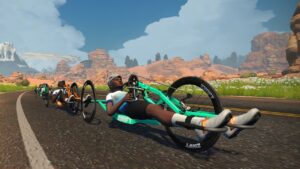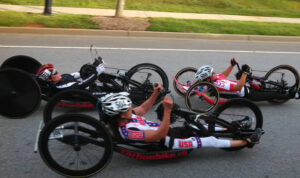Mount Washington is the tallest mountain in the Northeastern United States at 6,288 feet and I’m fortunate enough to live in the valley below it. The Mt Washington Auto Road is a steep, narrow mountain road with no guardrails. The climb into the clouds is known for its treacherous road and steep incline with an average grade of 12%.
Over the last few decades, a handful of handcyclists have tackled the legendary road. Mostly on adaptive mountain bikes due to the gravel stretches of the road up above the treeline. Erik Kondo of Massachusetts is the only handcyclist to make the trek under his own power and with no electric motor, it took him 8.5 hours. More recently two female cyclists have done it with electric assistance on the adaptive mountain bikes. When I heard that the Auto Road was paved the entire length of the road last year I decided to attempt it on my road cycling handcycle with the goal of beating Erik’s 8.5 hour mark. With new gearing on my bike, I’ve been able to climb gradients as steep as 16-18%, for short distances. This new technology coupled with the newly paved Auto Road is what gave me the confidence to attempt the fastest known time for handcyclists on Mt Washington.
I made my attempt as part of Adaptive Sports Partners ‘Sunrise Ascent’ fundraiser. It’s a hike-a-thon style fundraiser for the adaptive sports program that has hikers ascending the mountain from various points early in the pre-dawn hours to reach the summit to watch the sun come up. Adaptive Sports Partners has some off-road rickshaws that some teams use to help participants with physical disabilities reach the summit. Some participants use their own adaptive sports equipment to climb the road, usually with some assistance either from an electric motor or muscle power from able-bodied hikers. This year, I was the only handcyclist to attempt the climb with the intention to do it all under my own power.
The organizers insisted I have a few hikers with me as back-up so some friends and their sons joined me on the climb. During the first 3-4 miles I felt good in the dark and sheltered by the trees. I’ve climbed steeper roads and I’ve climbed 4000+’ before, but they were all shorter or had extended downhills and flat stretches to recover on. Mount Washington does not ease up at all for 7.5 miles. As trees got smaller and smaller, I had to stop for more and more breaks and my backup hikers kept offering to help ‘tow’ me and I kept refusing.
Finally, when I was spending more time resting than pedaling I let the boys wrap some nylon webbing around my footrests and then their waists for the last few miles. The climb only got tougher when we went up above the elevation where the wind blows non-stop. With the boy’s help and my continued pedaling, we maintained a steady 2-3 mph though. Going into this I thought that the biggest challenge was going to be the last couple hundred yards which are a 19-20% gradient. I’m still not sure about that stretch of road, but I know I have a lot of work to do to get to the point where I can ride to that steep grade on my own next year.
Admittedly, I was a little disappointed that I didn’t make it to the top completely under my own power. But I found comfort knowing that only one or two guys have done it on handcycles, and one of them took 8 hours so making it halfway in around 3 was a good first try. There’s no road east of the Rockies that big, that steep and that long. I’ve got a few tweaks to make to my bike for another try next year so it was a good learning experience and first try.
I’d like to make a few changes before I attempt the climb again next year with changes to my bike and myself as well. I think implementing a healthy diet and sticking to a steady training plan will help tremendously. For my bike, a lighter and stiffer frame and other mechanical changes can be made to my bike to make the steep climbs a little easier.
Last winter, I started using a Wahoo Kickr Snap ‘smart’ trainer that lets riders use the Zwift virtual cycling app. Zwift has created various digital worlds all with their own cycling routes with simulated climbs, descents, flats. The computer in the trainer adjusts the resistance applied to the wheel of the bike to mimic the terrain you see on the TV or computer screen. Zwift has created virtual versions of real-life Tour de France climbs like Mount Ventoux. This climb is close to Mount Washington and will be a big part of my off-season training this winter. I find it a lot easier to get a quick ride on the trainer in my living room after work.
My next ride is in September at the annual Kelly Brush Foundation ride in Middlebury, Vermont. It’s a ride to help fundraise for the KBF, an amazing foundation that helps people with spinal cord injuries with grants for adaptive sports equipment. This year, I plan to enjoy my day in Vermont and ride the 50 mile route and I am really looking forward to it, it’s a great ride.




